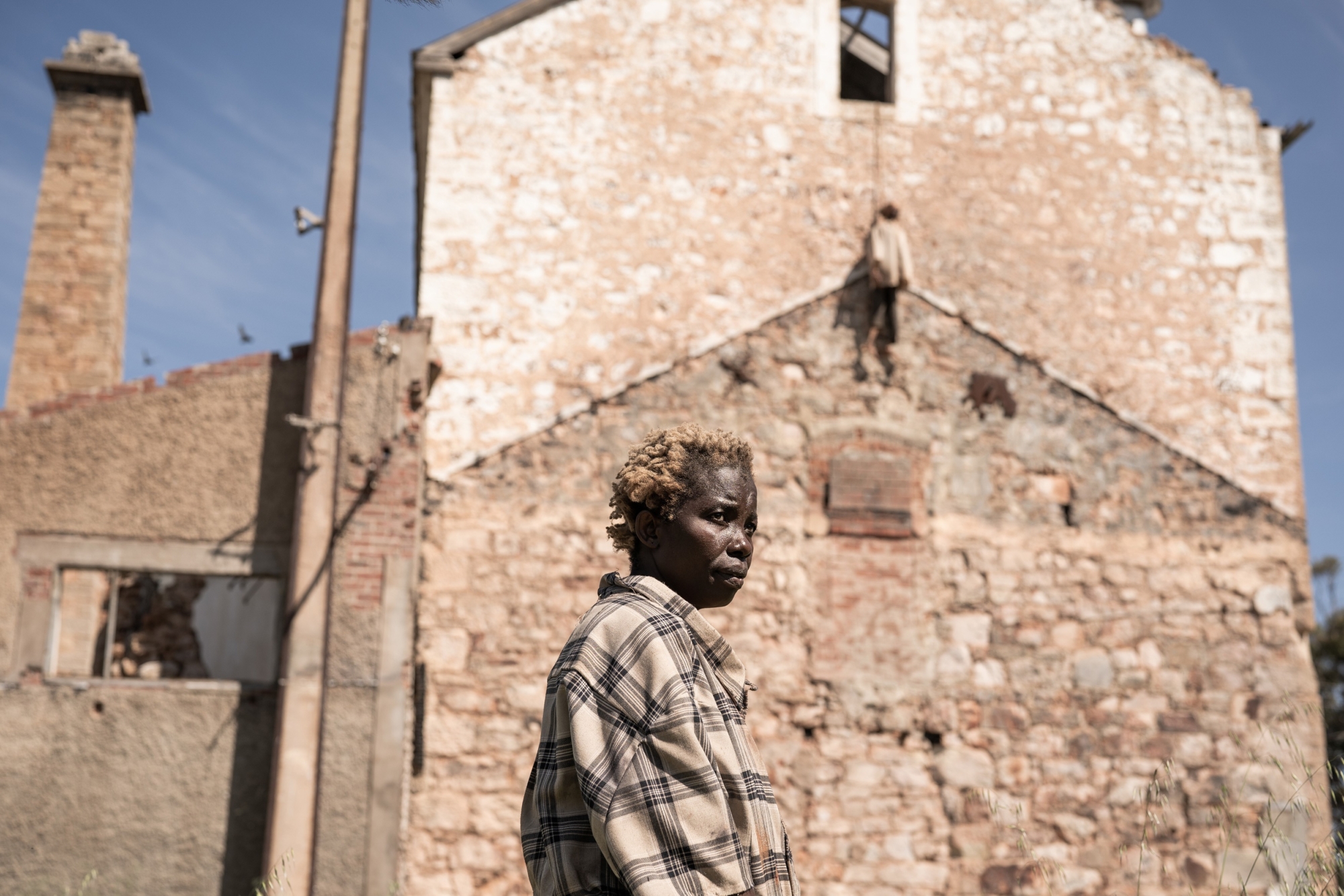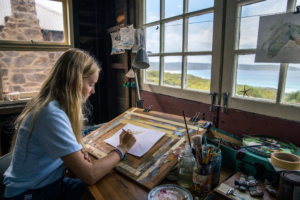A new film from Rolf de Heer always demands attention. It has been an uncharacteristically long time since his last directorial effort, Charlie’s Country (2013), notwithstanding his contribution to the anthology In the Same Garden (various directors, 2016) and production credits on a handful of titles directed by Molly Reynolds including Another Country (2015) and My Name is Gulpilil (2021), the latter of which closed his decades-long collaboration with the late David Gulpilil.[1]See Kath Dooley, ‘One Final Bow: An Actor Reflects in Molly Reynolds’ My Name Is Gulpilil’, Metro, no. 209, 2021, pp. 56–9, <https://metromagazine.com.au/one-final-bow/>, accessed 2 November 2023. The Survival of Kindness (2022) represents a new chapter for de Heer, evident in its distinctive production methodology and in the bracing contemporaneity of its subject, which is delivered with the even-handed temperament of a parable. Produced in part by the Adelaide Film Festival Investment Fund, The Survival of Kindness had its premiere at the festival in October 2022, before playing in Competition at the Berlin Film Festival in February 2023; it will doubtless continue to challenge audiences and provoke conversation as it reaches new audiences.
De Heer has often been comfortable working in a vein of cinematic restraint, but The Survival of Kindness may be his most concertedly minimal work yet. It establishes its cinematic style in its opening minutes, as its protagonist (unnamed in the course of the film, but credited as BlackWoman, and played by newcomer Mwajemi Hussein) is placed in a cage on a trailer by a group of gasmask-wearing assailants and driven out to a blasted desert salt pan, where she is left in the cage to die. Cinematographer Maxx Corkindale alternates tight close-ups that pick out and linger on small visual details in shallow focus, with wide shots emphasising the scale of the landscape. As the film cross-fades between different geometrical views of the trailer, extreme close-ups depict ants emerging from a crack in the ground, their bodies twisting and contorting as they engage in combat. Their cacophonous chirring overwhelms the soundtrack, until their bodies lie curled, dead, on the salt pan and BlackWoman emerges from the cage, having managed to torturously craft her escape with makeshift tools.

In the film’s first act, BlackWoman traverses these harsh surroundings on foot, encountering hints of the horror that has befallen this world: ruined, abandoned farmhouses; hanged bodies dangling overhead. At times, the film recalls Walkabout (Nicolas Roeg, 1971) as it regards the psychedelic strangeness of the inhospitable Australian outback (the first half of the film was shot in South Australia’s Flinders Ranges). There is a Bressonian quality to the presentation of BlackWoman: the camera may hold tightly on her face and her expressive eyes as she reacts wordlessly to some off-screen atrocity. In another early scene, we hear the sound of her dress flapping in the breeze as she sobs, her back turned to the camera. Composer Anna Liebzeit’s music is deployed sparingly, sometimes as an ambient accompaniment to the passage through the desert, turning discordant in moments of terror.
De Heer has often been comfortable working in a vein of cinematic restraint, but The Survival of Kindness may be his most concertedly minimal work yet.
For the most part, The Survival of Kindness is without dialogue. When characters do speak, their dialogue is unsubtitled, and at times seemingly consists of made-up sounds – a creative decision that sits alongside de Heer’s more idiosyncratic (see, for instance, his 2007 silent comedy Dr Plonk), while also emphasising the film’s theme of suffering arising from failure to communicate and empathise with others.
The film is divided into two distinct halves, with a mountain at its centre. BlackWoman arrives at the mountain, scales it and emerges down the other side into more verdant surroundings, entering a segregated society where gasmasked individuals wait for buses while unmasked people of colour are either pursued and detained into coerced slavery or summarily executed. Shot around Hobart, the second half of the film recalls The Nightingale (Jennifer Kent, 2018) in its use of Tasmania’s natural environs and colonial architecture as a backdrop for horrific violence. With her identity concealed beneath a purloined gasmask, BlackWoman is able to pass unnoticed through these surroundings. She takes refuge in a disused train workshop, where she encounters fellow fugitives BrownGirl (Deepthi Sharma) and BrownBoy (Darsan Sharma). While the film permits this impromptu family some brief shared moments of levity, de Heer has yet darker turns in mind.
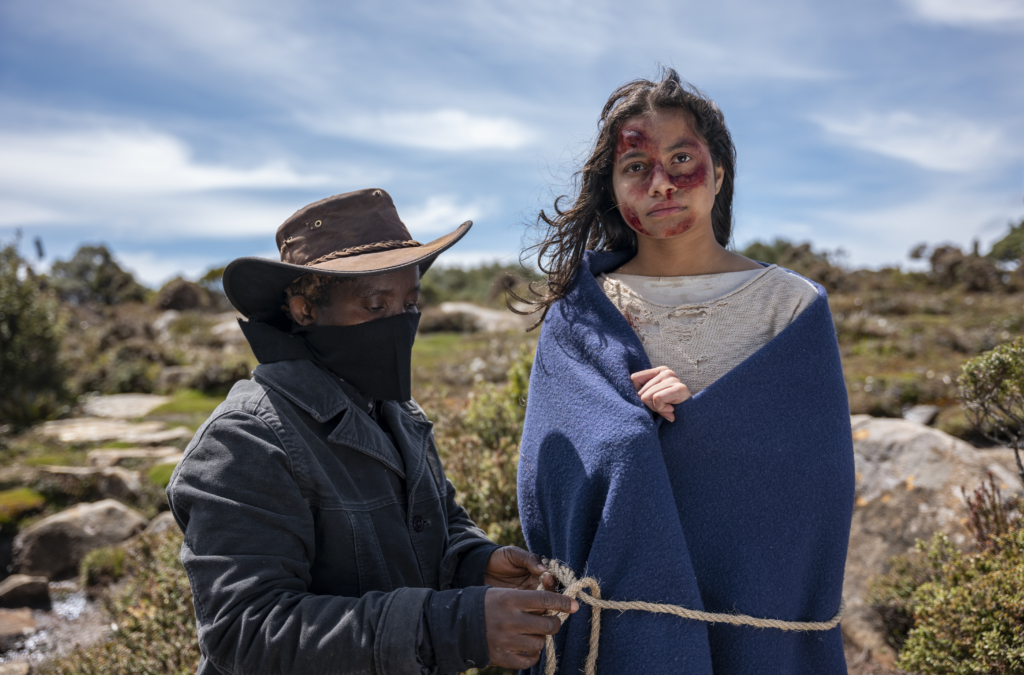
The mountain is key to the bifurcated structure of The Survival of Kindness and, according to de Heer, essential to its origins.[2]‘In Conversation with Rolf de Heer and Julie Byrne’, panel discussion, Adelaide Film Festival, 29 October 2022. Indeed, the film’s working title was The Mountain.[3]See ‘South Australian Screen Production Hits New Peak in Statewide Boom’, media release, South Australian Film Corporation, 20 October 2021, <https://www.safilm.com.au/latest-news/south-australian-screen-production-hits-new-peak-in-statewide-boom/>, accessed 2 November 2023. In a discussion panel with producer Julie Byrne at the 2022 Adelaide Film Festival, de Heer recounted how the film’s inspiration came to him while driving and walking around Hobart’s Mount Wellington during the COVID-19 pandemic, when progress on a long-developing, elaborate international co-production project had stalled. Haunted by radio news reports of callous indifference from conservative UK politicians towards the disproportionate impact of the pandemic on minority groups,[4]See Sonia Faleiro, ‘Britain’s Ethnic Minorities Are Being Left for Dead’, The New York Times, 22 May 2020, <https://www.nytimes.com/2020/05/22/opinion/britain-coronavirus-minorities.html>, accessed 2 November 2023. de Heer began to conceptualise a more immediate, small-scale film, exploring ‘the collision between the pandemic […] and Black Lives Matter’.[5]Rolf de Heer, ‘In Conversation with Rolf de Heer and Julie Byrne’, op. cit.
In execution, The Survival of Kindness is so sparse that it permits divergent interpretations; nonetheless, specific images provide jolts of recognition, variously evoking the pandemic, the brutal colonial history of Tasmania or unfolding climate disasters.
In execution, The Survival of Kindness is so sparse that it permits divergent interpretations; nonetheless, specific images provide jolts of recognition, variously evoking the pandemic, the brutal colonial history of Tasmania or unfolding climate disasters. The film’s blasted landscape and the allegorical presence of BlackWoman prompt further contemplation on the impact of extreme weather in the developing world – particularly as it relates to concerns that competition for resources will lead to the fracturing and reordering of societies around racial, class and geographical lines, leading to the kind of systemic oppression glimpsed in the film.[6]See Damian Carrington, ‘Disasters Linked to Climate Can Increase Risk of Armed Conflict’, The Guardian, 26 July 2016, <https://www.theguardian.com/environment/2016/jul/25/disasters-linked-to-climate-can-increase-risk-of-armed-conflict>, accessed 2 November 2023.
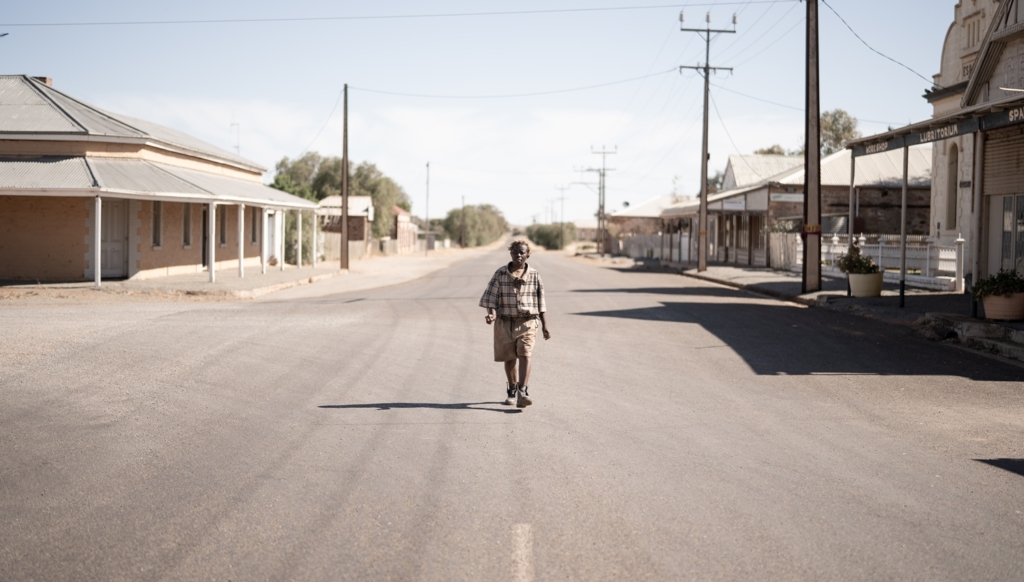
In the same conversation, de Heer spoke of the film’s casting. Originally, he wrote the role of the central character for fellow Ten Canoes (2006) director Peter Djigirr, who became unable to proceed with the role due to health issues.[7]‘In Conversation with Rolf de Heer and Julie Byrne’, op. cit. De Heer next tried to cast the part from Tasmania’s refugee community, at which time he began to reconceptualise the central character as a woman. Hussein, who arrived in Adelaide in 2005 after having escaped war in the Democratic Republic of the Congo and spent eight years in a refugee camp in Tanzania,[8]See Triptych Pictures, Vertigo Productions, Screen Tasmania & Adelaide Film Festival, The Survival of Kindness press kit, 2022, p. 18. was encouraged to submit an audition video by a friend who heard that casting agents were looking for a woman of her age for the lead. Despite her lack of acting experience, she was cast shortly after meeting with de Heer.[9]Cath Clarke, ‘The Survival of Kindness Actor Mwajemi Hussein: “They Were About to Kill Us”’, The Guardian, 18 February 2023,<https://www.theguardian.com/film/2023/feb/17/the-survival-of-kindness-actor-mwajemi-hussein-rolf-de-heer>, accessed 2 November 2023.
De Heer was determined that the production would depart from his established working modes. Given the film’s subject matter, and the difficult conditions in which it would be made – particularly in the early South Australian sequences – de Heer forewent reuniting many of his regular collaborators. Instead, he envisioned a much more rapid production process, working with an extremely small crew of emerging filmmakers as heads of department, including cinematographer Corkindale and two recent Indigenous graduates from Flinders University, production designer Maya Coombs and sound designer, sound recordist and FX editor Adam Dixon-Galea.[10]‘First Nations Spotlight: Damien Wanganeen, Maya Coombs and Adam Galea’, Ausfilm, 21 March 2022, <https://www.ausfilm.com.au/news/ausfilm-first-nations-spotlight-damien-wanganeen-maya-coombs-and-adam-galea/>, accessed 18 February 2023. The young crew members were supported by established mentors, including editor Sean Lahiff and regular de Heer collaborators James Currie, Tom Heuzenroeder (both sound designers) and Beverley Freeman (make-up).
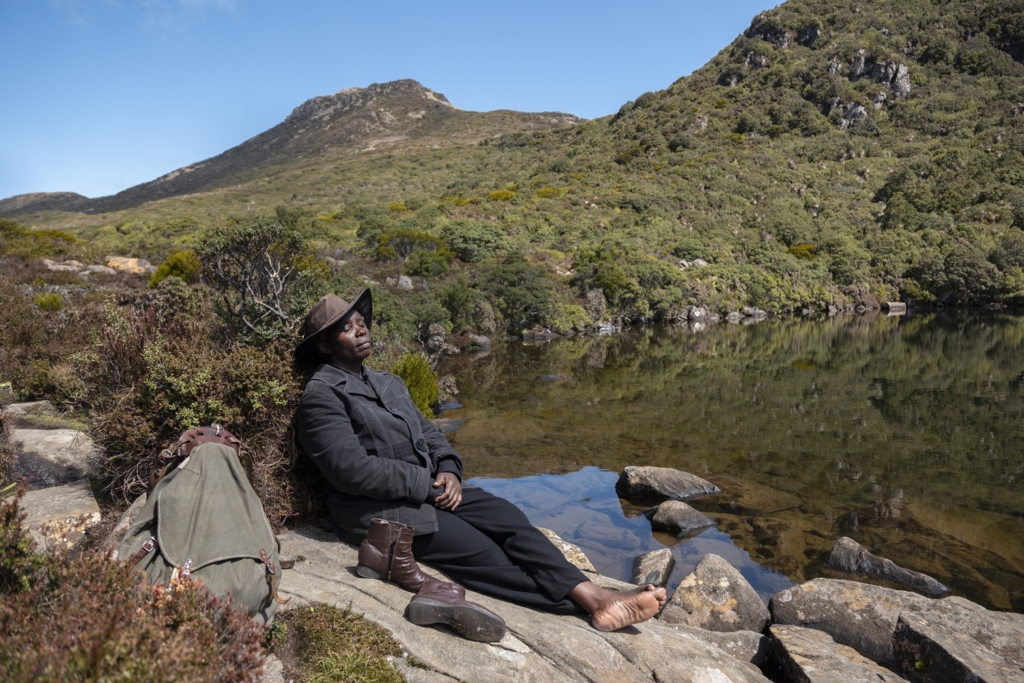
Given the persistence of critical debates around issues of representation, authenticity, who has the authority to tell such stories and the general ethics of depicting the suffering of people from marginalised backgrounds on screen, it is unsurprising that critiques of this nature have been directed at de Heer over this film.[11]See, for example, Patrick Frater, ‘Stunning Acting Debut by Mwajemi Hussein Elevates The Survival of Kindness as It Juxtaposes Pandemic and Racism – Berlin Competition’, Variety, 17 February 2023, <https://variety.com/2023/film/news/survival-of-kindness-pandemic-racism-berlin-1235526385/>; and Daniel Fairfax, ‘Sweet Madness: The 2023 Berlinale’, Senses of Cinema, no. 105, May 2023, <https://www.sensesofcinema.com/2023/festival-reports/sweet-madness-the-2023-berlinale/>, both accessed 2 November 2023. However, even a cursory sample of the director’s body of work reveals that he has never shied away from challenging audiences with uncomfortable visions. At the material level of production, de Heer is at a stage in his career where he is committed to creating opportunities for others and sharing the filmmaking experience with them. Speaking in 2021 about the South Australian Film Corporation’s funding of the film and other works, CEO Kate Croser hailed the importance of supporting productions that provide ‘invaluable career pathways for local First Nations practitioners’.[12]‘South Australian Screen Production Hits New Peak in Statewide Boom’, op. cit.
It is unsurprising that critiques … have been directed at de Heer over this film. However, even a cursory sample of the director’s body of work reveals that he has never shied away from challenging audiences with uncomfortable visions.
In the panel discussion at the Adelaide Film Festival, de Heer was cagey about discussing the themes of the film, expressing a preference for it to speak for itself.[13]‘In Conversation with Rolf de Heer and Julie Byrne’, op. cit. It is evident, however, that he has long been attuned to issues of social disadvantage and marginalised identities in his filmmaking, whether it be disability in Dance Me to My Song (1998), the impact of colonialism abroad in The Old Man Who Read Love Stories (2001), the dark secrets of suburbia in Alexandra’s Project (2003), First Nations storytelling traditions in Ten Canoes, and Indigenous–colonial relations in Australia in The Tracker (2002) and Charlie’s Country (2013). Several of these films are defined by a striking degree of cross-cultural collaboration and co-authorship.[14]See Luke Buckmaster, ‘Ten Canoes Rewatched – Ethnographic Document Meets High-spirited Whimsy’, The Guardian, 3 January 2016, <https://www.theguardian.com/film/2016/jan/03/ten-canoes-rewatched-ethnographic-document-meets-high-spirited-whimsy>, accessed 2 November 2023. Perhaps surprisingly, however, when considered in relation to de Heer’s prolific oeuvre, The Survival of Kindness’ narrative structure most closely resembles his breakout feature, Bad Boy Bubby (1993). Both films find their protagonists confined to captivity in their early scenes before they emerge into worlds that they, along with the viewer, experience as strange and unfamiliar.
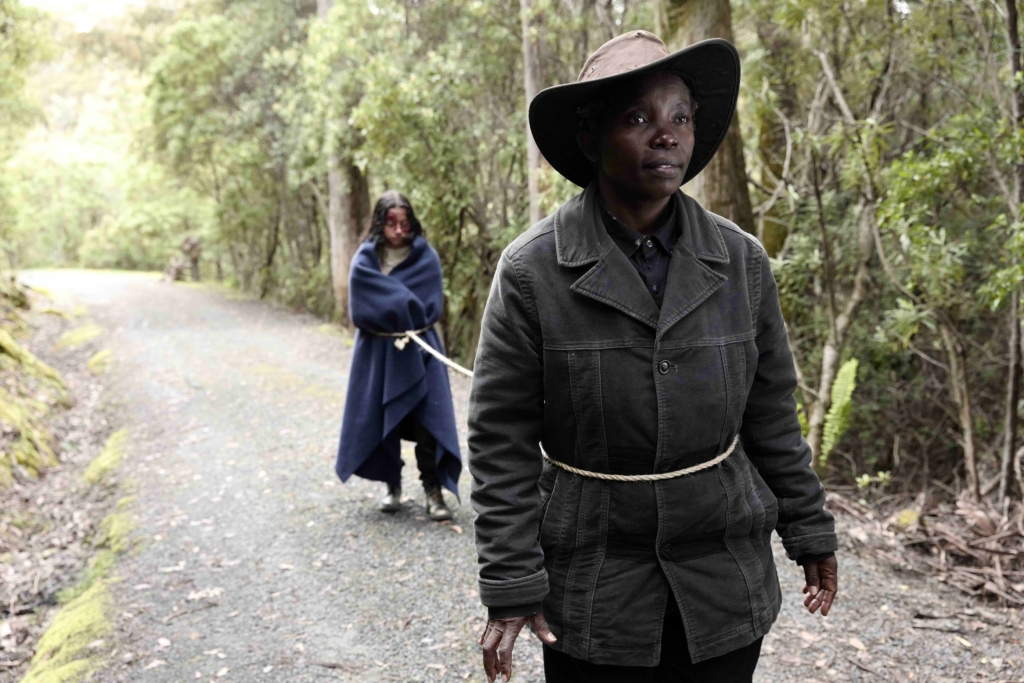
The two films’ narratives are shaped by radically different contexts. Bubby’s (Nicholas Hope) isolation is the work of a single act of cruelty, and he emerges onto the busy streets of Port Adelaide as something of a Kaspar Hauser figure,[15]See ‘Who Was Caspar [sic] Hauser?’, The Atlantic Monthly, vol. 7, no. 39, January 1861, available at <https://www.theatlantic.com/magazine/archive/1861/01/who-was-caspar-hauser/628783/>, accessed 2 November 2023. taking on new mannerisms and patterns of speech with each encounter. By contrast, BlackWoman is a person without a past; The Survival of Kindness carefully limits the constraints of her characterisation so that we can only speculate what her life may have been like prior to the events depicted in the film. As with Bad Boy Bubby, a gasmask plays a central narrative role in the film, a crucial prop that permits entry into the wider world. For BlackWoman, the landscape she encounters is largely empty, perhaps post-apocalyptic. The Survival of Kindness gives room for viewers to speculate whether the violent transformation of the society seen in the film has been brought on by pandemic, environmental disaster or some other catastrophic change. At times, its surroundings are strangely antiquarian; much of the production design for the ephemera of a world gone by has a distinctively early-twentieth-century flavour, comprising seemingly useless objects that mock the petty aspirations of a once affluent time. By the film’s end, BlackWoman has experienced the gamut of the world’s horrors, and the film comes full circle with a Bressonian flourish – for a hopeful viewer, one that may offer a metaphysical possibility of transcendence, even though it comes at a steep personal price.
An elemental allegory for our time, The Survival of Kindness provides room for its viewers to arrive at their own meanings; but for many, it will remain a most bitter pill. For de Heer, one of Australia’s most important filmmakers, it is a particularly personal work, perhaps something of an occluded portrait of his present circumstances and thoughts. As the film invites allegorical readings, one reflects on the mountain that divides the film, separating the South Australian locales that have provided the setting for so many of de Heer’s films from his new home in Tasmania. That island state and its capital provide a new and distinct backdrop, complete with its own architecture and considerable historical legacies. Always a careful observer of people and places, de Heer draws on his surroundings – and, through the process of cinema, radically defamiliarises them for us, putting that which has been obscured right in front of our faces. An optimistic reading of The Survival of Kindness suggests that, in the bleakest of circumstances, small acts of kindness might yet outlive us, even as the world itself becomes uninhabitable. A more despairing viewer might conclude that some horrors, once experienced, simply cannot be endured. De Heer leaves both possibilities open for his audience. The Survival of Kindness bears witness, mutely.
Endnotes
| 1 | See Kath Dooley, ‘One Final Bow: An Actor Reflects in Molly Reynolds’ My Name Is Gulpilil’, Metro, no. 209, 2021, pp. 56–9, <https://metromagazine.com.au/one-final-bow/>, accessed 2 November 2023. |
|---|---|
| 2 | ‘In Conversation with Rolf de Heer and Julie Byrne’, panel discussion, Adelaide Film Festival, 29 October 2022. |
| 3 | See ‘South Australian Screen Production Hits New Peak in Statewide Boom’, media release, South Australian Film Corporation, 20 October 2021, <https://www.safilm.com.au/latest-news/south-australian-screen-production-hits-new-peak-in-statewide-boom/>, accessed 2 November 2023. |
| 4 | See Sonia Faleiro, ‘Britain’s Ethnic Minorities Are Being Left for Dead’, The New York Times, 22 May 2020, <https://www.nytimes.com/2020/05/22/opinion/britain-coronavirus-minorities.html>, accessed 2 November 2023. |
| 5 | Rolf de Heer, ‘In Conversation with Rolf de Heer and Julie Byrne’, op. cit. |
| 6 | See Damian Carrington, ‘Disasters Linked to Climate Can Increase Risk of Armed Conflict’, The Guardian, 26 July 2016, <https://www.theguardian.com/environment/2016/jul/25/disasters-linked-to-climate-can-increase-risk-of-armed-conflict>, accessed 2 November 2023. |
| 7 | ‘In Conversation with Rolf de Heer and Julie Byrne’, op. cit. |
| 8 | See Triptych Pictures, Vertigo Productions, Screen Tasmania & Adelaide Film Festival, The Survival of Kindness press kit, 2022, p. 18. |
| 9 | Cath Clarke, ‘The Survival of Kindness Actor Mwajemi Hussein: “They Were About to Kill Us”’, The Guardian, 18 February 2023,<https://www.theguardian.com/film/2023/feb/17/the-survival-of-kindness-actor-mwajemi-hussein-rolf-de-heer>, accessed 2 November 2023. |
| 10 | ‘First Nations Spotlight: Damien Wanganeen, Maya Coombs and Adam Galea’, Ausfilm, 21 March 2022, <https://www.ausfilm.com.au/news/ausfilm-first-nations-spotlight-damien-wanganeen-maya-coombs-and-adam-galea/>, accessed 18 February 2023. |
| 11 | See, for example, Patrick Frater, ‘Stunning Acting Debut by Mwajemi Hussein Elevates The Survival of Kindness as It Juxtaposes Pandemic and Racism – Berlin Competition’, Variety, 17 February 2023, <https://variety.com/2023/film/news/survival-of-kindness-pandemic-racism-berlin-1235526385/>; and Daniel Fairfax, ‘Sweet Madness: The 2023 Berlinale’, Senses of Cinema, no. 105, May 2023, <https://www.sensesofcinema.com/2023/festival-reports/sweet-madness-the-2023-berlinale/>, both accessed 2 November 2023. |
| 12 | ‘South Australian Screen Production Hits New Peak in Statewide Boom’, op. cit. |
| 13 | ‘In Conversation with Rolf de Heer and Julie Byrne’, op. cit. |
| 14 | See Luke Buckmaster, ‘Ten Canoes Rewatched – Ethnographic Document Meets High-spirited Whimsy’, The Guardian, 3 January 2016, <https://www.theguardian.com/film/2016/jan/03/ten-canoes-rewatched-ethnographic-document-meets-high-spirited-whimsy>, accessed 2 November 2023. |
| 15 | See ‘Who Was Caspar [sic] Hauser?’, The Atlantic Monthly, vol. 7, no. 39, January 1861, available at <https://www.theatlantic.com/magazine/archive/1861/01/who-was-caspar-hauser/628783/>, accessed 2 November 2023. |
